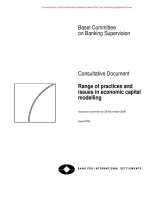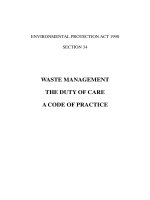Concrete pavement repair manuals of practice
Bạn đang xem bản rút gọn của tài liệu. Xem và tải ngay bản đầy đủ của tài liệu tại đây (9.5 MB, 265 trang )
SHRP-H-349
Concrete Pavement Repair
Manuals of Practice
J ?
• !"
_'. *o
. . , ~ . - _
,.+ • . _ 4+" • .
j_/
t_ • J
Materials and Proceduresfor the Repair
of Joint Seals in Concrete Pavements
Lynn D. Evans, A. Russell Romine
Materials and Proceduresfor Rapid Repair of
Partial-Depth Spalls in Concrete Pavements
Arti J. Patel, Cynthia A. Good Mojab, A. Russell Romine
ERES Consultants, Inc., Savoy, Illinois
Strategic Highway Research Program
National Research Council
SHRP-H-349
ISBN 0-309-05608-X
Contract H-106
Product no. 3003
Program Manager: Don M. Harriott
Project Manager: Shashikant C. Shah
Program Area Secretary: Francine A. Burgess
August 1993
Reprinted September 1994
key words:
bituminous
cementitious
inspection
joint resealing
patching
pavement maintenance
polymer
portland cement concrete
sealant
spall repair
Strategic Highway Research Program
National Research Council
2101 Constitution Avenue N.W.
Washington, DC 20418
(202) 334-3774
The publication of this report does not necessarily indicate approval or endorsement by the
National Academy of Sciences, the United States Government, or the American Association
of State Highway and Transportation Officials or its member states of the findings, opinions,
conclusions, or recommendations either inferred or specifically expressed herein.
©1993 National Academy of Sciences
1.5M/NAP/0893
IM/NAP/0994
Preface
This book contains two pavement maintenance manuals
intended for use by highway maintenance agencies and
contracted maintenance firms in the field and in the office.
Each is a compendium of good practices for portland cement
concrete (PCC) joint resealing and partial-depth spall repair,
respectively, stemming from two Strategic Highway
Research Program (SHRP) studies.
In project H-105, Innovative Materials and Equipment for
Pavement Surface Repair, the researchers conducted a
massive literature review and a nationwide survey of
highway agencies to identify potentially cost-effective repair
and treatment options. The information and findings from
this study were then used in the subsequent field experiments
conducted under project H-106, Innovative Materials
Development and Testing.
In the H-106 project, the installation and evaluation of many
different test sections were conducted to determine the cost-
effectiveness of maintenance materials and procedures. Test
sections were installed at 22 sites throughout the United
States and Canada between March 1991 and February 1992,
under the supervision of SHRP representatives. The
researchers collected installation and productivity information
at each site and periodically evaluated the experimental
repairs and treatments for 18 months following installation.
Long-term performance and cost-effectiveness information
for the various repair and treatment materials and procedures
was not available at the time these manuals were prepared.
However, subsequent performance evaluations may lead to
future editions of these manuals to address performance and
cost-effectiveness more thoroughly.
111
For the reader's convenience, potentially unfamiliar terms
are italicized at their first occurrence in the manuals and are
defined in glossaries. Readers who want more information
on topics included in the manuals should refer the reference
lists for each manual. The final report for the H-106 project
may be of particular interest to many readers. 2 It details the
installation procedures, laboratory testing of the materials,
and field performance of each of the repair and treatment
types.
iv
Acknowledgments
The research described herein was supported by the Strategic
Highway Research Program (SHRP). SHRP is a unit of the
National Research Council that was authorized by Section
128 of the Surface Transportation and Uniform Relocation
Assistance Act of 1987.
Special thanks are due the project management team at
SHRP, and to the following highway agencies.
Manual for joint repair:
Arizona Department of Transportation
Colorado Department of Transportation
Iowa Department of Transportation
Kentucky Transportation Cabinet
South Carolina Department of Highways and Public
Transportation
Manual for spall repair:
Arizona Department of Transportation
Commonwealth of Pennsylvania Department of
Transportation
South Carolina Department of Highways and Public
Transportation
Utah Department of Transportation
The contributions of the following individuals are also
acknowledged.
Manual for joint repair: David Peshkin, Michael Darter,
Sam Carpenter, Michael Belangie, Henry Bankie, Jim
Chehovits, and Jeff Randle.
Manual tbr spall repair: Michael Darter, Sam Carpenter,
Leo Ferroni, and David Peshkin.
Materials and Procedures
for the Repair of Joint Seals
in Concrete Pavements
Manual of Practice
: : ::.:
::i::_:i:I:i::=:'_::/._:::_II.II_
//_I_I_,S__",//,,,2_:,,,,:_:,,,/:, , ,, ,, ,,, ,, ,,,,,,, ,: ,, ,,,,,,:,,,/,,:,,,,,,,,
:==' ':::. ' .": ':i:_ _:"(=_:(:"_ ' ' •:: .:. = '::.:. %1 ._._.:::: ::.
i.:::::.:._i
':: . :.
Strategic Highway Research Program
National Research Council
Contents
Preface iii
Acknowledgments vi
1.0 Introduction 1
1.1 Scope of Manual 1
1.2 Overview 1
2.0 Need for Joint Resealing 3
2.1 Seal Condition 3
2.2 Pavement Condition 9
2.3 Climatic Conditions 11
2.4 Traffic Level 13
2.5 Determining the Need to Reseal 13
3.0 Planning and Design 15
3.1 Primary Considerations 15
3.2 Objective for Resealing 15
3.3 Accounting for Existing Conditions 16
3.4 Selecting a Sealant Material 17
3.5 Selecting Backer Materials 20
3.6 Selecting Primer Materials 22
3.7 Selecting Joint Reservoir Dimensions 22
3.8 Selecting Preparation and
Installation Procedures 26
3.9 Selecting Equipment 28
3.9.1 Joint Plow 30
3.9.2 Concrete Saw 32
3.9.3 Abrasive Blasting Equipment 33
3.9.4 Airblasting Equipment 35
3.9.5 Hot Airblasting Equipment 36
3.9.6 Backer-Rod Installation Tools 36
3.9.7 Hot-Applied Sealant Installation
Equipment 37
3.9.8 Silicone Sealant Applicators 38
3.9.9 Other Equipment 39
vii
3.10 Estimating Material, Labor,
and Equipment Requirements 39
3.11 Determining Cost-Effectiveness 41
3.11.1 Material and Shipping Costs 42
3.11.2 Labor Costs 42
3.11.3 Equipment Costs 43
3.11.4 User Delay Costs 43
3.11.5 Cost-Effectiveness Comparisons . 43
4.0 Construction 47
4.1 Traffic Control 47
4.2 Safety Precautions 47
4.3 Preparing the Joints 48
4.3.1 Removing the Old Sealant 48
4.3.2 Refacing the Joint Sidewalls 51
4.3.3 Abrasive Blasting the
Joint Sidewalls 53
4.3.4 Airblasting the Joint Reservoir 56
4.3.5 Installing Primer 59
4.4 Material Preparation and Installation 59
4.4.1 Installing Backer Rod 60
4.4.2 Sealant Installation 63
4.4.2.1 Hot-Applied Sealant 64
Heating the Sealant 64
Methods for Installation 66
Cleanup Requirements 69
Safety Precautions 70
4.4.2.2 Cold-Applied Sealant . 70
Loading Sealant into the
Pumping Apparatus 71
Methods for Installation 71
Cleanup Requirements 74
5.0 Evaluation of Joint Seal Performance 75
°,°
VIII
Appendix A Material Testing Specifications 77
Appendix B Sample Cost-Effectiveness Calculations 81
Appendix C Material and Equipment Safety Precautions 87
Appendix D Inspection Checklists for Construction 89
Appendix E Partial List of Material and
Equipment Sources 103
Glossary 107
References 111
ix
Figures
Figure 1. Pavement survey form 4
Figure 2. Sealant adhesion failure 7
Figure 3. Full-depth spall distress 9
Figure 4. Typical joint cross-section 23
Figure 5. Rear-mounted joint plow 30
Figure 6. Belly-mounted joint plow 31
Figure 7. Concrete joint saw 32
Figure 8. Abrasive blasting equipment 34
Figure 9. Air compressor 35
Figure 10. Automated backer-rod installation tool 37
Figure 11. Joint plowing operation 50
Figure 12. Joint sawing operation 52
Figure 13. Abrasive blasting operation 55
Figure 14. Airblasting operation 57
Figure 15. Backer-rod installation 62
Figure 16. Hot-applied sealant installation 67
Figure 17. Silicone sealant installation 72
Figure 18. Example joint seal deterioration chart 76
xi
Tables
Table 1. Decision table for resealing PCC joints 5
Table 2. Climatic region parameters 12
Table 3. Traffic level rating 13
Table 4. Relationship between pavement condition
and sealing objectives 17
Table 5. Indicators learned from original sealant . 18
Table 6. Summary of sealant materials 19
Table 7. Backer-rod materials 21
Table 8. Typical recommended shape factors (W:T) . 24
Table 9. Typical joint design dimensions 25
Table 10. Joint preparation/installation procedures . . . 27
Table 11. Joint resealing equipment requirements 29
Table 12. Production rates, costs, and amounts 40
Table 13. Material and shipping costs 44
Table 14. Labor costs 44
Table 15. Equipment costs 45
Table 16. Cost-effectiveness worksheet 46
Table 17. Troubleshooting procedures for plowing . 51
Table 18. Troubleshooting procedures for resawing . . 53
xiii
Table 19. Troubleshooting procedures for
sandblasting 56
Table 20. Troubleshooting procedures for
airblasting 58
Table 21. Troubleshooting procedures for
backer-rod installation 63
Table 22. Troubleshooting procedures for
hot-applied sealant installation 68-69
Table 23. Troubleshooting procedures for
cold-applied sealant installation 73-74
Table A-1. Rubberized asphalt specifications 78
Table A-2. Nonsag silicone sealant specifications 79
Table A-3. Self-leveling silicone sealant specification 80
Table B-1. Example material and shipping costs 82
Table B-2. Example labor costs 83
Table B-3. Example equipment costs 84
Table B-4. Example cost-effectiveness calculations . 85
xiv
1.0 Introduction
This manual has been prepared for use by maintenance
engineers, maintenance field supervisors, crew persons,
maintenance contractors, and inspectors as an easy reference
for resealing* transverse and longitudinal joints in portland
cement concrete (PCC) pavements.
1.1 Scope of Manual
Included in this manual are descriptions of procedures and
materials recommended for resealing joints in PCC
pavements. Guidelines for planning a resealing project as
well as steps for installing joint seals and inspecting the
process are presented. The resealing of concrete-asphalt
shoulder joints or sealing cracks in PCC pavements is not
addressed. The information contained in this manual is
based on the most recent research, obtained through reviews
of literature and of current practice as well as from the field
results of an ongoing study.1'2 This study investigates the
performance in PCC joints of various hot- and cold-applied
sealants using several methods of installation.
1.2 Overview
Several steps are required for successful resealing of joints in
PCC pavements. The first is determining the need for
resealing the joints. Chapter 2 contains a general procedure
for deciding whether to reseal. This procedure can be easily
modified to meet the needs of each highway agency.
Italicizedwordsaxedefinedin theglossary.
Once the need for resealing is determined, the next step is
planning the operation. Chapter 3 leads the maintenance
planner through the steps for selecting sealant and accessory
materials, choosing preparation and installation procedures,
specifying equipment, and estimating material and labor
requirements.
The construction phase of joint resealing is described in
chapter 4. Details of each step of the preparation and
installation operations are listed along with troubleshooting
procedures for each operation.
In addition, the appendices provide material testing
specifications, sample cost-effectiveness calculations, safety
precautions, and inspection checklists to help ensure good
resealing practices and high-quality results.
2
2.0 Need for Joint Resealing
Excessive delay in replacing a failing sealant system in
concrete pavement joints can result in more rapid
deterioration of the pavement. However, if sealant is
replaced too early, precious maintenance funds may not have
been used in the most cost-effective manner. How, then, can
those responsible for maintenance determine when is the best
time to reseal joints in concrete pavements? Some states
specify that joints be resealed when a specified amount of
sealant material (25 to 50 percent) has failed, allowing
moisture and/or incompressible materials to progress past the
sealant to the underlying layers. Other agencies base their
decision on pavement type, pavement and sealant condition,
and available funding.
Another more complete method to determine whether or not
a pavement needs to be resealed is to calculate rating
numbers based on the sealant and pavement condition, traffic
levels, and climatic conditions. Figure 1 presents a
worksheet that can be used to estimate these properties, and
table 1 gives the user recommendations about the need to
reseal, based on these properties. The following sections
assist in determining the necessary ratings and conditions.
2.1 Seal Condition
Joint-sealant system effectiveness is judged by the sealant's
ability to resist embedment of incompressible materials and
the sealant system's success in preventing entry of water and
incompressibles into the joint. To evaluate pavement seal
condition, the following steps should be completed and
results recorded on figure 1:
I
Sealant Condition Pavement Condition ° I
I
iiiiiiiiiiiiiii_iii_i_i_i_i_ii!i_i!iiiiiiiiiiiiiii_i_i_i_i_i_i_i_iiiiiiiii_ !_ _::i, ::?:_::_::?:?:!::_::i::!::i::i::i::i::i::i::i_i::i::i::i_::i_?:_i::_:_!::_i!::_::iiiiiiiiiiii::i::i::i::i::ii::i_i!!ii_i_
10 ::10-301 > 30 i i
. ! Expected pavement _> 10 _5-10 1 < 5
Water
entering,
%
length
<
_ _ . life, yrs _ _ .
-: _ i<0.06! 0.06- i>0.12
I i I
Stone intrusion i Low _Med !High Avg. faulting, in
_ _ _ 0.12
_ ; _
Sealant Rating iGoodlFairiPoor Coraerbreal_,%slabs I <1! 1-5 i >5
: : _ _ _
Pumping, % joints i <1 i 1-5 i >5
Environmental Conditions ° Spans> 1 in, % slabs i <5 i 5-I0i >10
Avg. annual precip., in i Pavement rating !Good! Fair [ Poor
Days < 32°F (0°C) !
z Current Joint v.snes;-n
Avg. low / high temp, °F !
WF WNF
Climatic region • _ DF DNF Sealant age, yrs
Avg. sealant depth, in i
Traffic Conditions Avg. joint width, in
ADT (vpd); % Tracks i i Avg. joint depth, in
4
Traffic level b i Low i Med iHigh Max. joint spacing, ft ::
Sce table 2.
See table 3.
1 inch = 25.4 mm; 1 ft = 0.305 m
Figure 1. Pavement survey form
Table 1. Decision table for resealing PCC joints
Climatic Region
Sealant Pvmt. Traffic
Freeze Nonfreeze
Rating Rating Rating
Wet :_ Dry Wet i Dry
Fair Good Low Possibly i Possibly Possibly i Possibly
J I
i ° ,_ ° :
Fair Good Med Yes i Possibly Possibly i Possibly
i ° ,; ° _:
Fair Good High Yes i Yes Yes i Possibly
i
Fair Fair Low Yes :_Possibly Possibly Possibly
Fair Fair Med Yes i Yes Yes i Possibly
_ al.
Fair Fair High Yes i Yes Yes i Possibly
Fair Poor Low Possibly i Possibly Possibly i Possibly
J
_ ,; • :
Fair Poor Med Yes i Yes Yes i Possibly
Fair Poor High Yes i Yes Yes i Yes
Poor Good Low Yes i Possibly Possibly i Possibly
1 ! ": q _
Poor Good Med Yes i Yes Yes i Possibly
Poor Good High Yes i Yes Yes i Yes
Poor Fair Low Yes i Yes Yes i Possibly
Poor Fair Med Yes i Yes Yes i Yes
" o _:
Poor Fair High Yes _ Yes Yes _ Yes
Poor Poor Low Yes i Yes Yes i Possibly
i 4 ,; i _
Poor Poor Med Yes i Yes Yes i Yes
I i .; i ;
Poor Poor High Yes ! Yes Yes i Yes
a Sealants rated in "Good" condition do not require replacement.
• Choose 10 or more joints whose sealant condition is
representative of the entire site. If large variations in
condition are evident, subdivide the site into sections
having similar seal condition and evaluate 5 to 10
joints from each section.
• Cut 2-in (51-mm) samples of sealant from a few
joints and measure the joint width, depth, and sealant
thickness.
• Determine from the construction records the type and
age of the sealant and the design joint width and
sealant thickness.
• Record the maximum spacing between joints.
Carefully inspect each of the 10 or more chosen joints,
recording the following items on figure 1:
• Water resistance is the percent of overall joint length
where water can bypass the sealant and enter the
joint.
• Stone intrusion is the amount of stones, sand, and
debris that is embedded in the sealant.
Loss of bonding to the concrete sidewall, shown in figure 2,
full-depth spalls, shown in figure 3, and torn or missing
sealant are common joint seal distresses. They reduce water
resistance and allow moisture, sand, and dirt to enter the
joint. Bond failure can be determined by pulling the sealant
away from the joint edge and inspecting for adhesion failure.
Full-depth spalls can be identified by gently inserting a dull
knife into the spall and observing whether the knife tip can
pass below the sealant. Another method for locating areas of
bond failure is with a vacuum tester as developed by the
Iowa Department of Transportation. The percent of water
resistance loss can be computed using equation 1.
6
deeply embedded in the sealant or filling
the joint (or material embedded between
the sealant and the channel face and
entering the joint below the sealant).
Next, determine the sealant rating by calculating the sealant
condition number (SCN). This number can be computed
using the following equation:
SCN = I(L) + 2(/14) + 3(/-/) (2)
where:
SCN = Sealant condition number
L = The number of low-severity sealant conditions
from figure 1
M = The number of medium-severity conditions
H = The number of high-severity sealant conditions
Use the SCN and the following chart to determine whether
the existing joint seal is in good, fair, or poor condition, and
circle the correct sealant rating on figure 1.
Sealant Rating SCN
Good 0 to 1
Fair 2 to 3
Poor 4 to 6
Results of a sealant condition rating can also be used to
monitor the performance of joint seals and to assist in
follow-up rehabilitation planning.
8
Figure 3. Full-depth spall distress
2.2 Pavement Condition
A pavement will provide several indicators that the joint seal
is not performing adequately and is allowing too much water
to reach the underlying layers. These indicators include:
• Surface staining or the accumulation of fine material
on the surface close to joints or cracks indicates
pumping of the base or subbase. This results, in part,
from excess moisture and it contributes to formation
9
of voids beneath the pavement, cracks, and comer
breaks.
• Faulting, or dropoff between adjacent slabs, possibly
indicates that excess moisture is reaching a water,
susceptible base and/or subgrade, and that voids are
forming beneath one side of the pavement as a result
of continual traffic.
• D-cracking of susceptible pavement can result from
excess moisture beneath a pavement.
A pavement system can also manifest the effects of the
entrance of stones and other incompressible materials into
pavement joints by the following:
• Compression-related spalls are present of the walls of
joints that are filled with sand and stones.
• Blowups have occurred and slab edges have shattered.
There has been a permanent increase in joint width
causing movement of nearby bridge supports.
To evaluate the condition of a pavement considered for
resealing, record the following items in the pavement
condition section of figure 1. These items should be based
on field inspection and the maintenance schedule.
1. The estimated number of years before the pavement
requires major rehabilitation
2. The average vertical faulting movement
3. The percent of slabs containing comer breaks
4. The percent of joints visually indicating pumping
5. The percent of slabs containing full-depth spalls
extending greater than 1 in (25.4 mm) or more from
the face of the joint
10
To determine a pavement condition number (PCN), use
figure 1 and equation 3.
PCN = 1(L) + 2(M) + 3 C/-/) (3)
where:
PCN = Pavement condition number
L = The number of low-severity pavement
condition indicators from figure 1
M = The number of medium-severity pavement
condition indicators
H = The number of high-severity pavement
condition indicators
Use the PCN and the following chart to determine whether
the existing pavement is in good, fair, or poor condition, and
circle the correct pavement rating on figure 1:
Pavement Rating PCN
Good 0 to 3
Fair 4 to 5
Poor 6 to 15
2.3 Climatic Conditions
The effects of extreme temperatures and precipitation on
joint seal and pavement performance cannot be minimized.
In extreme cold, sealants are stretched the most as pavements
shrink and joints widen. Extreme heat results in expanding
slabs and shrinking joints. This can compress improperly
placed sealant so that it is forced above the pavement surface
and may be pulled out by passing traffic.
11
Wet climatic regions need highly effective seals, approaching
100 percent effectiveness to prevent water damage to the
base and pavement structures. Similarly, dry climates also
require highly effective seals in order to prevent the intrusion
of incompressible material into the joint, which can result in
joint growth, blowups, and structural damage.
When evaluating the climatic conditions that a pavement will
experience, determine for that location the following
information and enter it in the environmental condition
section of figure 1:
• The normal annual total precipitation for the location
• The mean number of days in a year with a minimum
temperature of 32°F (0°C) or below
• The highest and lowest recorded temperatures
This information is available from the National Climatic Data
Center in Asheville, N.C., or from local weather recording
stations. Then, using the information on figure 1 and table 2,
identify the climatic region in which the pavement is located.
Circle the correct climatic region on figure 1.
Table 2. Climatic region parameters
Climatic MeanAnnualDays AverageAnnual
Region <_32°F(0"C) Precipitation
Wet-fieeze > 100 > 25 in (635 mm)
Wet-nonfreeze < 100 > 25 in (635 mm)
Dry-freeze > 100 < 25 in (635 mm)
Dry-nonfreeze < 100 < 25 in (635 mm)
12
2.4 Traffic Level
To identify traffic conditions, obtain the average daily traffic
(ADT) level in vehicles per day (vpd) and the percent truck
traffic. Determine the traffic level rating from table 3. If the
percent truck traffic is greater than 10 percent or the
expected growth rate is greater than 5 percent, borderline
traffic level ratings should be increased one level.
Table 3. Traffic level rating
Traffic Level ADT, vpd all lanes
Low < 5,000
Medium 5,000 to 35,000
High > 35,000
2.5 Determining the Need to Reseal
After completing the pavement evaluation worksheet, use
table 1 and the calculated sealant rating (SCN), pavement
rating (PCN), the traffic rating, and the climatic region to
evaluate the need for resealing. The table makes
recommendations about the need for resealing based on the
ratings of the evaluation worksheet. The basis for the table
is engineering experience; however, it can be adjusted to the
needs and policies of individual state agencies. Choose the
row with the combination of sealant, pavement, and traffic
rating from the three left-hand columns that match the
pavement being evaluated. Then, find the intersection of that
row with the appropriate climatic region to obtain the
recommendation on the need for resealing.
13









